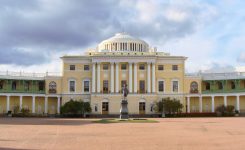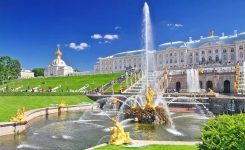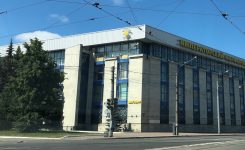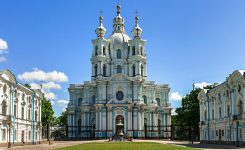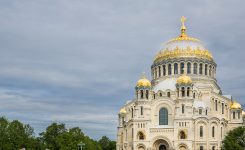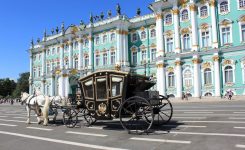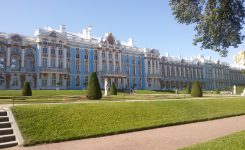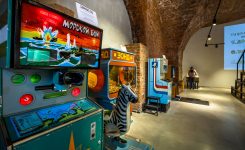Museum, Tours
ストロガノフ宮殿
The first house for the Stroganovs was built on the site probably in the 1720s. It was a one-storey building. Architect Mikhail Zemtsov erected a second, two-storey house on the site in the 1740s.In 1752, Baron Sergei Stroganov commissioned the palace design from Italian architect Bartolomeo Rastrelli, then at work extending the Catherine Palace and building the Smolny Convent for Empress Elisabeth. Since the Stroganovs were the richest family in Russia and were related to the Empress by marriage, Rastrelli could not turn down the commission and hastily prepared a design for the townhouse.[1]Like the Vorontsov Palace (also designed by Rastrelli for Stroganov’s in-law Mikhail Vorontsov), the Stroganov Palace was not rapidly built. The Main Staircase decorated with marble sculptures led to the elegant Grand Hall, which featured a huge painting by Venetian artist Giuseppe Valeriani. After Sergei Stroganov’s death in 1756, the decoration was completed by his son Alexander in 1760. Within several years, the new empress, Catherine II introduced the Neoclassical taste. The style was also championed by Alexander Stroganov, who became President of the Imperial Academy of Arts in 1800. Great HallIn the 1790s and 1800s decades, architect Andrei Voronikhin was charged with refurbishing the interiors in Neoclassical style. Voronikhin’s mother was the Stroganovs’ serf, and it was rumored that his father was Alexander Stroganov.[2] The first suites by Voronikhin were the Mineral Study, Picture Gallery, Library and Alexander Stroganov’s Physics Cabinet. Another two enfilades in the west wing were created for Pavel Stroganov, of which the Small Drawing Room survives.After Alexander Stroganov died in 1811, the palace passed to his son Pavel. Pavel Stroganov had four daughters, but his only son was killed in the Battle of Craonne. He then established the Stroganov entail, i.e., a non-divisible estate which would pass to the oldest family member. This chain of ownership was preserved until 1919 when the last Count Sergei Stroganov sold his rights to the entail. A new apartment was decorated for Aglaida Pavlovna Stroganov by Carlo Rossi in 1820 (it later disappeared almost totally). After the October Revolution in 1917, the remaining Stroganovs emigrated from Russia, and the palace was nationalized.[1] The family line is now extinct.The Soviets declared the palace a national museum chronicling the lifestyle of the Russian nobility. In 1929 the museum was shut down, and much of its contents (including some priceless paintings and objets d’art) were taken to the Hermitage Museum.[3] The palace was handed over to a botanical institute. The Ministry of Shipbuilding occupied the premises for half a century, starting in 1939.In 1988 the palace was given to the Russian Museum and became a branch housing some of its exhibitions.[4] The dilapidated building underwent a thorough and painstaking restoration process between 1991 and the present moment. In keeping with Rastrelli’s original design, its walls are now painted light pink (rather than dark green, as they were in the mid-20th century). It is one of the few Baroque structures on Nevsky Prospect to preserve its original appearance.[1]
The main façade of the Stroganov palace faces Nevsky Prospect. Here, Rastrelli rejects the cour d’honneur in the French manner, like the one in the design of the Vorontsov Palace, built by Rastrelli in 1744-1750. By this time, Rastrelli has developed his own style based on exploring the impressive façade, which implies the presence of three risolites, the subordination to a single center, rejection of verticalization, and stretching the building horizontally. Rastrelli gives the building a single mass movement toward the center. He skillfully emphasizes this by subordinating the lateral risolites to the central, imposing group of columns of purely decorative, not architectonic, function, deliberately building up tension toward the center of the sculpted front.Increasing plastic expression toward the center is a favorite method of the architect’s for producing strong concentration in a building. Rastrelli uses the giant order, the method of visual fusion of the second and third floor windows, typical for the Baroque, and the differentiated arrangement of columns closely adjacent to the wall in order to create a masterful effect and an impressive Baroque façade facing St. Petersburg’s main thoroughfare. There is no doubt that Italian architect Guarino Guarini’s heritage is reflected in the Russian architect’s work. It should be mentioned that a treatise on architecture by Guarino Guarini gained popularity in Europe, including remote St. Petersburg. It’s likely that the architects who worked at the Russian Empress’ court, including Rastrelli himself, who was the chief court architect, were familiar with the basic precepts of this work and often resorted to the constructive methods of its author.The facade carries an entrance arch supported by two Corinthian columns. The arch is crowned with a pediment bearing the Stroganov coat of arms.[4] The spaces under the windows on the facade feature a man’s profile. There are two practically anecdotal versions regarding this man’s identity. According to one version, the man is the first owner of the palace, Baron Stroganov, whom Rastrelli wanted to surprise. However, many historians claim that the famous architect in fact left his own profile on the palace walls. According to this version, Rastrelli decided to do this as an unusual signature to commemorate his work.[5]


